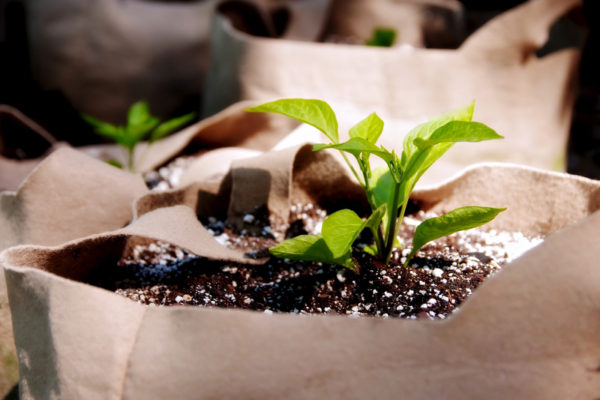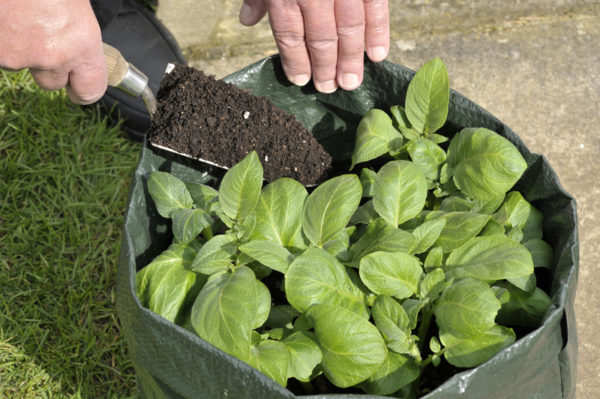Should I Use Smart Pots (Grow Bags) in Hot Climates

I do a lot of container gardening, especially with fruit trees in the Arizona desert. I’ve been having success for years growing in containers even when temps soar into the triple digits. Smart Pots or Grow Bags have become a fairly popular method for gardening or growing fruit trees, but can they withstand in a hot environment?
Can you use Smart Pots in hot climates? Absolutely! They can present some challenges with retaining moisture in hot, dry climates. If you’re willing to make some accommodations they’re definitely doable. It’s up to you to determine if the pros outweigh the cons, but this post will help you make an informed decision.
What are Smart Pots
Smart pots are large fabric bags that are shaped similar to a standard nursery container. The fabric is made of recycled polypropylene fabric, which consists of an aerated structure.
Originally used by many nurseries for containing trees, they’ve found a place in backyard gardens. The belief is that they foster healthier roots systems through air pruning, which then creates a healthy plant.
Smart Bags can be purchased in various gallon sizes similar to standard size nursery pots. Click here for current options and pricing on amazon.
Why grow in bag versus a solid container?

There are many benefits for utilizing smart pots. These grow bags prevent the roots from circling around the container. In a standard round plastic container when the roots hit the plastic sides they have nowhere to go, so as they grow they circle around the container.
This can ultimately girdle and choke out the plant if left unpruned or in the same pot for too long. It’s referred to as being root bound – when the roots fill the entire container with nowhere to go.
The fabric on smart pots allows for air, which naturally prunes the roots, so once they hit the sides they don’t circle. This creates a fibrous root system allowing for healthy nutrient uptake for the plant.
Ceramic type pots or even plastic can easily be broken when dropped or hit by an object, which isn’t an issue with grow bags. Grow bags can be somewhat lighter then solid materials if you intend to move the pots around the yard. The bags are breathable and release heat which can help keep the roots cooler.
Lastly, you can control the soil in a grow bag. Our native soil is clay and it often takes years of adding organic matter to help make the soil more conducive for plants to thrive in. With grow bags you can utilize optimal soil from the start.
Challenges with Smart Pots in Hot Climates
Ok, so it’s not all easy utilizing grow bags in hot climates, but with all the benefits it can be worth the task. Here are some of the barriers with smart pots in hot climates.
Let’s take a look at some of the major issues with using Smart Pots in hot climates.
- The color. It’s no secret that black absorbs heat, this goes for any type of pot. Most smart pots are black. In a hot sun a black pot can fry the roots or dry out extremely quickly.
- Watering. The breathable fabric combined with being exposed to hot air dries the root ball up fast. When temps soar you’ll need to water frequently, which can mean multiple times a day. If you have some sort of irrigation system it can make this more manageable, but it’s still going to be a lot of watering.
- Durability. Heat exposure can really break down the fabric on these pots over time. They should last a few years, but they won’t be reliable for the long term in a hot climate.
RELATED POST: Growing Fruit Trees in Containers in Hot Climates
How to Make Them Work
Now that we’ve examined some of the potential issues with Smart Pots in the heat, let’s check out how to get around all that to make it work.
Irrigation System
If you intend to water by hand, it’s definitely going to be a challenge, unless it’s your full time job. Setting up a drip system on a timer is going to be a must to keep your bags consistently moist in the hot months. Check out my video on how I set-up a drip system for container fruit trees.
Shade the Pot
If you do end up purchasing the black or dark color bags, do something to shade the pot. Leaving the bags fully exposed to all day hot sun is going to dry them out quickly and potentially cause problems. I know cardboard isn’t pretty but I use it a lot in the summer to help shade my pots.
Keep in mind that the bags do need to breath so wrapping them with something or placing anything directly around the material can defeat the whole purpose of the bag.
Lighter Colors
As previously mentioned, black absorbs that sun and heats up quick. Try the tan option for hot climates. It’s going to stay a lot cooler and reflect some of that intense sun versus absorb it.
The Right Soil
I typically use a soil that promotes drainage when utilizing containers for fruit trees. Something like a cactus mix that has things like sand or lava sand. With Smart Pots, I’ve heard of local growers mixing in some of the native clay soil to help retain moisture.
Typically, I’d never recommend doing this in a plastic pot or solid material pot, but in a grow bag where you want the soil to retain more water it can help. A mix of 50% compost, 40% native, 10% sand was suggested by a local nursery owner that only uses smart pots.
Again, generally I’d never mix compost in my planting soil for containers because it can add heat around the roots, but in smart pots the heat has somewhere to go and isn’t trapped by the container.
RELATED POST: How to Improve Clay Soil for Fruit Trees
Final Thoughts
As you can see, growing with Smart pots is definitely worth checking out, even in a hot, dry climate. They can be a little tricky to work with in hot climates, but it can be done. If you’re someone that’s willing to put in a little extra work to get them through the heat, then give them a shot.
Please comment below on anything you’ve enjoyed from this post or how smart pots have worked for you in hot climates.
